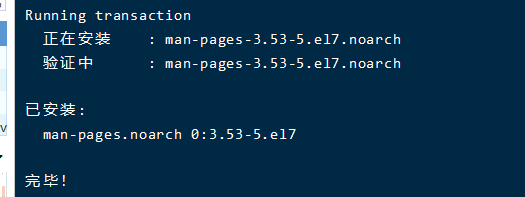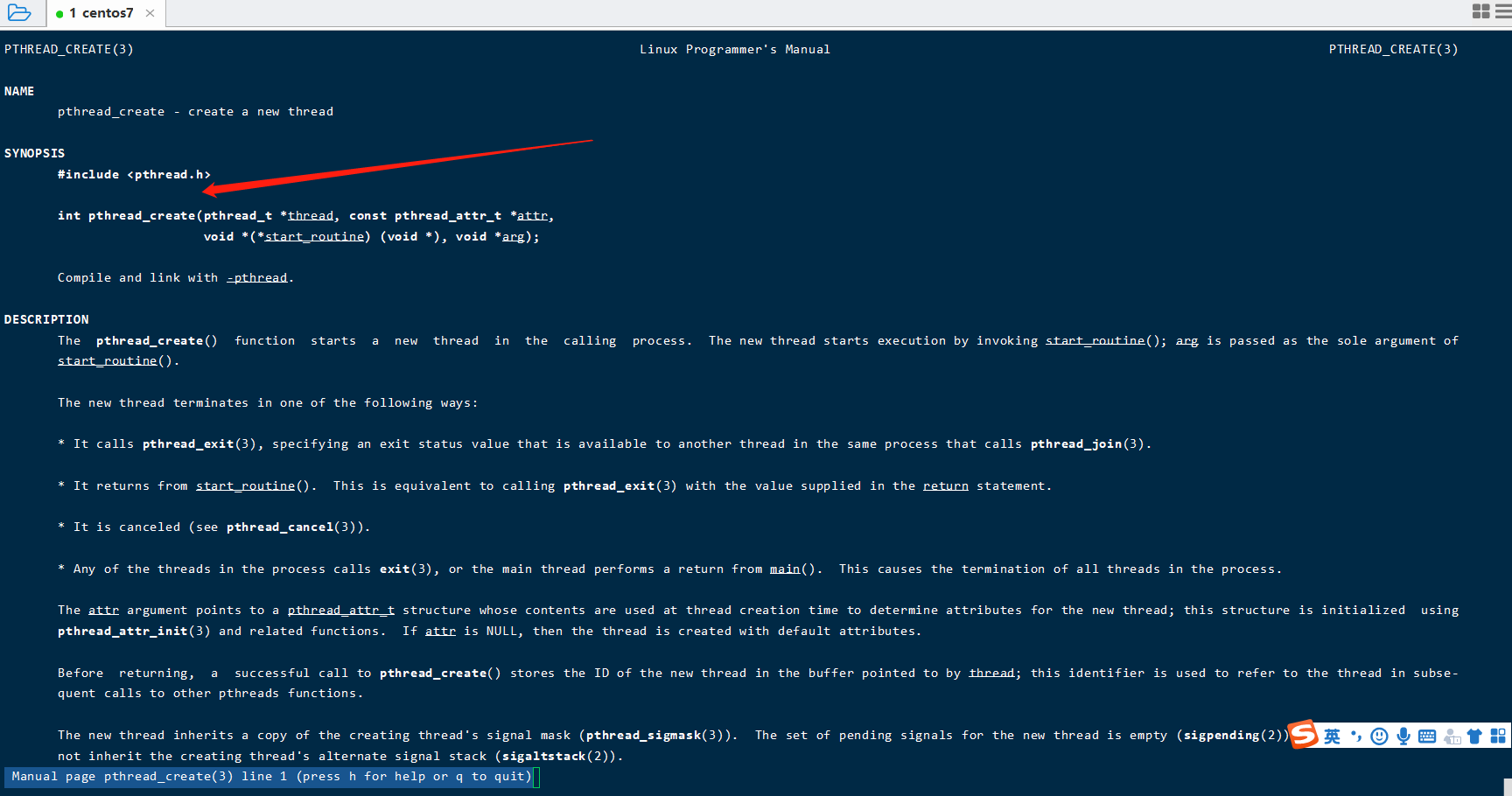本文是作者原创,版权归作者所有.若要转载,请注明出处.本文只贴我觉得比较重要的源码,其他不重要非关键的就不贴了
本文操作系统是centos7
1.查看 pthread_create 函数显示及其示例
man pthread_create

2.cengos下安装man手册命令:
yum install man-pages -y

3.重新查看 pthread_create 函数显示及其示例
man pthread_create
如下图

根据man配置的信息可以得出pthread_create会创建一个线程,这个函数是linux系统的函 数,可以用C或者C++直接调用,
上面信息也告诉程序员这个函数在pthread.h, 这个函数 有四个参数

一个小demo
#include <pthread.h>//头文件 #include <stdio.h> pthread_t pid;//定义一个变量,接受创建线程后的线程id //定义线程的主体函数 void* thread_entity(void* arg) { printf("i am new Thread!"); } //main方法,程序入口,main和java的main一样会产生一个进程,继而产生一个main线程 int main() { //调用操作系统的函数创建线程,注意四个参数 pthread_create(&pid,NULL,thread_entity,NULL); //usleep是睡眠的意思,那么这里的睡眠是让谁睡眠呢? //为什么需要睡眠?如果不睡眠会出现什么情况 usleep(100); printf("main "); }
4.那么java当中的线程和操作系统的线程是什么关系呢?,我们看下例子
public static void main(String[] args) { Thread thread = new Thread(){ @Override public void run() { System.out.println("i am new Thread!"); } }; thread.start(); }

上述例子可以看出:我们启用线程是调用start方法,而非直接调用run方法
5.我们追踪start方法的源码:
public synchronized void start() { /** * This method is not invoked for the main method thread or "system" * group threads created/set up by the VM. Any new functionality added * to this method in the future may have to also be added to the VM. * * A zero status value corresponds to state "NEW". */ if (threadStatus != 0) throw new IllegalThreadStateException(); /* Notify the group that this thread is about to be started * so that it can be added to the group's list of threads * and the group's unstarted count can be decremented. */ group.add(this); boolean started = false; try { start0();//这行是关键代码 started = true; } finally { try { if (!started) { group.threadStartFailed(this); } } catch (Throwable ignore) { /* do nothing. If start0 threw a Throwable then it will be passed up the call stack */ } } }
6.继续追踪我注释的这行关键代码start0()
private native void start0();
这个是native方法,具体实现需要查看openjdk的源码
7.openjdk的写jni一般是一一对应的,Thread.java对应的就是Thread.c
static JNINativeMethod methods[] = { {"start0", "()V", (void *)&JVM_StartThread}, {"stop0", "(" OBJ ")V", (void *)&JVM_StopThread}, {"isAlive", "()Z", (void *)&JVM_IsThreadAlive}, {"suspend0", "()V", (void *)&JVM_SuspendThread}, {"resume0", "()V", (void *)&JVM_ResumeThread}, {"setPriority0", "(I)V", (void *)&JVM_SetThreadPriority}, {"yield", "()V", (void *)&JVM_Yield}, {"sleep", "(J)V", (void *)&JVM_Sleep}, {"currentThread", "()" THD, (void *)&JVM_CurrentThread}, {"countStackFrames", "()I", (void *)&JVM_CountStackFrames}, {"interrupt0", "()V", (void *)&JVM_Interrupt}, {"isInterrupted", "(Z)Z", (void *)&JVM_IsInterrupted}, {"holdsLock", "(" OBJ ")Z", (void *)&JVM_HoldsLock}, {"getThreads", "()[" THD, (void *)&JVM_GetAllThreads}, {"dumpThreads", "([" THD ")[[" STE, (void *)&JVM_DumpThreads}, {"setNativeName", "(" STR ")V", (void *)&JVM_SetNativeThreadName}, };
8.start0其实就是JVM_StartThread。在jvm.h中找到了声明
/* * java.lang.Thread */ JNIEXPORT void JNICALL JVM_StartThread(JNIEnv *env, jobject thread);
9.在jvm.cpp中有实现,如下
JVM_ENTRY(void, JVM_StartThread(JNIEnv* env, jobject jthread)) JVMWrapper("JVM_StartThread"); JavaThread *native_thread = NULL; // We cannot hold the Threads_lock when we throw an exception, // due to rank ordering issues. Example: we might need to grab the // Heap_lock while we construct the exception. bool throw_illegal_thread_state = false; // We must release the Threads_lock before we can post a jvmti event // in Thread::start. { // Ensure that the C++ Thread and OSThread structures aren't freed before // we operate. MutexLocker mu(Threads_lock); // Since JDK 5 the java.lang.Thread threadStatus is used to prevent // re-starting an already started thread, so we should usually find // that the JavaThread is null. However for a JNI attached thread // there is a small window between the Thread object being created // (with its JavaThread set) and the update to its threadStatus, so we // have to check for this if (java_lang_Thread::thread(JNIHandles::resolve_non_null(jthread)) != NULL) { throw_illegal_thread_state = true; } else { // We could also check the stillborn flag to see if this thread was already stopped, but // for historical reasons we let the thread detect that itself when it starts running jlong size = java_lang_Thread::stackSize(JNIHandles::resolve_non_null(jthread)); // Allocate the C++ Thread structure and create the native thread. The // stack size retrieved from java is signed, but the constructor takes // size_t (an unsigned type), so avoid passing negative values which would // result in really large stacks. size_t sz = size > 0 ? (size_t) size : 0; native_thread = new JavaThread(&thread_entry, sz);//关键代码 // At this point it may be possible that no osthread was created for the // JavaThread due to lack of memory. Check for this situation and throw // an exception if necessary. Eventually we may want to change this so // that we only grab the lock if the thread was created successfully - // then we can also do this check and throw the exception in the // JavaThread constructor. if (native_thread->osthread() != NULL) { // Note: the current thread is not being used within "prepare". native_thread->prepare(jthread); } } } if (throw_illegal_thread_state) { THROW(vmSymbols::java_lang_IllegalThreadStateException()); } assert(native_thread != NULL, "Starting null thread?"); if (native_thread->osthread() == NULL) { // No one should hold a reference to the 'native_thread'. delete native_thread; if (JvmtiExport::should_post_resource_exhausted()) { JvmtiExport::post_resource_exhausted( JVMTI_RESOURCE_EXHAUSTED_OOM_ERROR | JVMTI_RESOURCE_EXHAUSTED_THREADS, "unable to create new native thread"); } THROW_MSG(vmSymbols::java_lang_OutOfMemoryError(), "unable to create new native thread"); } Thread::start(native_thread); JVM_END
10.大概浏览上下文,native_thread的构造应该是在JavaThread的构造中完成的.再看new JavaThread(...)这步
JavaThread::JavaThread(ThreadFunction entry_point, size_t stack_sz) : Thread() #if INCLUDE_ALL_GCS , _satb_mark_queue(&_satb_mark_queue_set), _dirty_card_queue(&_dirty_card_queue_set) #endif // INCLUDE_ALL_GCS { if (TraceThreadEvents) { tty->print_cr("creating thread %p", this); } initialize(); _jni_attach_state = _not_attaching_via_jni; set_entry_point(entry_point); os::ThreadType thr_type = os::java_thread; thr_type = entry_point == &compiler_thread_entry ? os::compiler_thread : os::java_thread; os::create_thread(this, thr_type, stack_sz);//这里创建线程 _safepoint_visible = false; }
11.到了os::create_thread这步,具体实现在os_linux.cpp中(这里我们只说linux的,其他系统的实现就不在这里了)
bool os::create_thread(Thread* thread, ThreadType thr_type, size_t stack_size) {
assert(thread->osthread() == NULL, "caller responsible");
// Allocate the OSThread object
OSThread* osthread = new OSThread(NULL, NULL);
if (osthread == NULL) {
return false;
}
// set the correct thread state
osthread->set_thread_type(thr_type);
// Initial state is ALLOCATED but not INITIALIZED
osthread->set_state(ALLOCATED);
thread->set_osthread(osthread);
// init thread attributes
pthread_attr_t attr;
pthread_attr_init(&attr);
pthread_attr_setdetachstate(&attr, PTHREAD_CREATE_DETACHED);
// stack size
if (os::Linux::supports_variable_stack_size()) {
// calculate stack size if it's not specified by caller
if (stack_size == 0) {
stack_size = os::Linux::default_stack_size(thr_type);
switch (thr_type) {
case os::java_thread:
// Java threads use ThreadStackSize which default value can be
// changed with the flag -Xss
assert (JavaThread::stack_size_at_create() > 0, "this should be set");
stack_size = JavaThread::stack_size_at_create();
break;
case os::compiler_thread:
if (CompilerThreadStackSize > 0) {
stack_size = (size_t)(CompilerThreadStackSize * K);
break;
} // else fall through:
// use VMThreadStackSize if CompilerThreadStackSize is not defined
case os::vm_thread:
case os::pgc_thread:
case os::cgc_thread:
case os::watcher_thread:
if (VMThreadStackSize > 0) stack_size = (size_t)(VMThreadStackSize * K);
break;
}
}
stack_size = MAX2(stack_size, os::Linux::min_stack_allowed);
pthread_attr_setstacksize(&attr, stack_size);
} else {
// let pthread_create() pick the default value.
}
// glibc guard page
pthread_attr_setguardsize(&attr, os::Linux::default_guard_size(thr_type));
ThreadState state;
{
// Serialize thread creation if we are running with fixed stack LinuxThreads
bool lock = os::Linux::is_LinuxThreads() && !os::Linux::is_floating_stack();
if (lock) {
os::Linux::createThread_lock()->lock_without_safepoint_check();
}
pthread_t tid;
int ret = pthread_create(&tid, &attr, (void* (*)(void*)) java_start, thread);//看这行代码,是不是就是linux系统的线程调用函数
pthread_attr_destroy(&attr);
if (ret != 0) {
if (PrintMiscellaneous && (Verbose || WizardMode)) {
perror("pthread_create()");
}
// Need to clean up stuff we've allocated so far
thread->set_osthread(NULL);
delete osthread;
if (lock) os::Linux::createThread_lock()->unlock();
return false;
}
// Store pthread info into the OSThread
osthread->set_pthread_id(tid);
// Wait until child thread is either initialized or aborted
{
Monitor* sync_with_child = osthread->startThread_lock();
MutexLockerEx ml(sync_with_child, Mutex::_no_safepoint_check_flag);
while ((state = osthread->get_state()) == ALLOCATED) {
sync_with_child->wait(Mutex::_no_safepoint_check_flag);
}
}
if (lock) {
os::Linux::createThread_lock()->unlock();
}
}
// Aborted due to thread limit being reached
if (state == ZOMBIE) {
thread->set_osthread(NULL);
delete osthread;
return false;
}
// The thread is returned suspended (in state INITIALIZED),
// and is started higher up in the call chain
assert(state == INITIALIZED, "race condition");
return true;
}
12.这里终于看到了系统库函数的调用。,看我注释的那行代码,是不是就是linux系统的线程调用函数pthread_create
调用线程执行的方法是java_start,参数是thread
看下源码
// Thread start routine for all newly created threads static void *java_start(Thread *thread) { // Try to randomize the cache line index of hot stack frames. // This helps when threads of the same stack traces evict each other's // cache lines. The threads can be either from the same JVM instance, or // from different JVM instances. The benefit is especially true for // processors with hyperthreading technology. static int counter = 0; int pid = os::current_process_id(); alloca(((pid ^ counter++) & 7) * 128); ThreadLocalStorage::set_thread(thread); OSThread* osthread = thread->osthread(); Monitor* sync = osthread->startThread_lock(); // non floating stack LinuxThreads needs extra check, see above if (!_thread_safety_check(thread)) { // notify parent thread MutexLockerEx ml(sync, Mutex::_no_safepoint_check_flag); osthread->set_state(ZOMBIE); sync->notify_all(); return NULL; } // thread_id is kernel thread id (similar to Solaris LWP id) osthread->set_thread_id(os::Linux::gettid()); if (UseNUMA) { int lgrp_id = os::numa_get_group_id(); if (lgrp_id != -1) { thread->set_lgrp_id(lgrp_id); } } // initialize signal mask for this thread os::Linux::hotspot_sigmask(thread); // initialize floating point control register os::Linux::init_thread_fpu_state(); // handshaking with parent thread { MutexLockerEx ml(sync, Mutex::_no_safepoint_check_flag); // notify parent thread osthread->set_state(INITIALIZED); sync->notify_all(); // wait until os::start_thread() while (osthread->get_state() == INITIALIZED) { sync->wait(Mutex::_no_safepoint_check_flag); } } // call one more level start routine thread->run();//终于找到run方法了 return 0; }
13.这个方法可以直接跳到最后一行,他执行的是传递过来对象的run方法
14.总结:由上面源码可以看到:Java的多线程是直接调用linux的多线程函数实现的
每个继承java.lang.Thread的类,调用start方法之后,都调用start0()的native方法;
start0()的native方法在openjdk里调用的是JVM_StartThread;
JVM_StartThread最终调用的是操作系统的pthread_create()函数,有四个参数,我们写的run方法就是该函数的第三个参数.